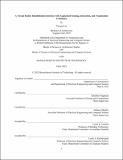A Virtual Reality Rehabilitation Interface with Augmented Sensing, Interaction, and Visualization Techniques
Author(s)
Lei, Yuxuan
DownloadThesis PDF (1.998Mb)
Advisor
Nagakura, Takehiko
Mueller, Stefanie
Terms of use
Metadata
Show full item recordAbstract
With the advanced development of multimodal sensing and rendering technologies, Virtual Reality (VR) has attracted enormous interest in unsupervised physical rehabilitation owing to its decisive advantages in turning traditional physical touchpoints into digital simulated empathy machinery. The shift from treatment rooms to the VR realm allows the scarce resource of rehabilitation services to reach a wider population. While traditional physical space designed the external environment, the virtual display satisfied users with self-awareness through virtual avatars and multisensory feedback. Thus, extensive research investigated innovative sensory input techniques, particularly motion tracking and mapping.
In response to this reverted design methodology, the primary object of this thesis is to survey an effective design and engineering paradigm of virtual rehabilitation spaces, including sensing technologies, interaction methods, and augmented feedback. The paper investigated a VR rehabilitation simulator that integrated muscle engagement sensing inputs, conventional motion simulation, and immersive VR displays. It is a three-in-one system consisting of two-dimensional input systems, a high-precision, low-latency optical motion capture system, a wearable Electrical Impedance Tomography (EIT) device, and an output system, a virtual rehabilitation environment that allows real-time visualization and interaction of muscle engagement and motion feedback. To validate the functionality and efficiency of this system, two user research were conducted. Study 1 evaluated how the enhanced system helped participants improve therapeutic exercise completion accuracy, while study 2 measured how the system empowered remote physical therapist evaluation quality without the in-clinic diagnosis. The results showed that muscle engagement visualization substantially improved the accuracy of therapeutic exercise (~15%) and facilitated the therapist's remote assessment quality. Finally, the paper discussed a range of alternative low-cost technologies, the future implication of the VR program as an at-home rehabilitation training tool, and more research directions.
Date issued
2022-05Department
Massachusetts Institute of Technology. Department of Electrical Engineering and Computer Science; Massachusetts Institute of Technology. Department of ArchitecturePublisher
Massachusetts Institute of Technology